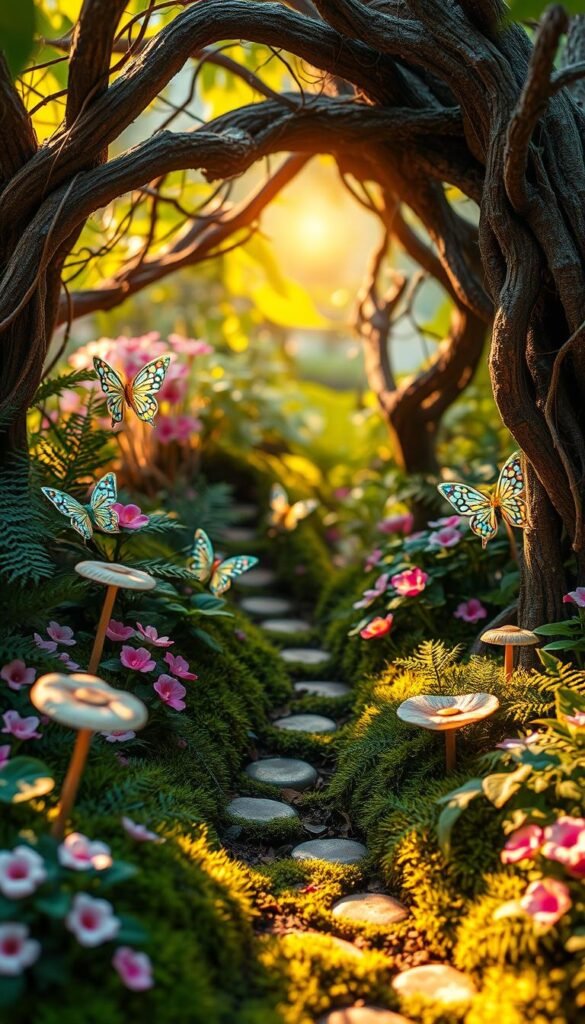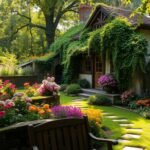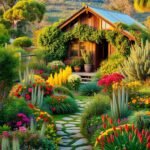Imagine crafting a tiny universe where every detail sparks joy. Miniature landscapes let you design captivating scenes that blend nature with creativity. These pocket-sized retreats thrive on thoughtful choices that balance visual appeal with storytelling charm.
Color selection forms the heartbeat of your creation. Soft mossy greens paired with lavender accents evoke peaceful meadows, while rich burgundies and golds suggest autumnal mystery. Earthy neutrals ground brighter tones, ensuring your composition feels cohesive rather than chaotic.
Layering materials adds depth to small spaces. Combine smooth stones with rough bark or feathery foliage to create tactile interest. Natural elements like twisted branches become arched bridges, transforming ordinary items into magical features.
Strategic arrangement guides viewers through your scene. Curved pathways invite exploration, while elevated elements draw the eye upward. Leave breathing room between focal points—crowded designs lose their enchanting effect.
Mastering these principles helps you build a world that feels alive. Whether you’re new to this craft or refining your skills, every choice shapes an immersive experience. Let’s explore how to elevate your approach with intention and flair.
Understanding the Enchantment of Fairy Gardens
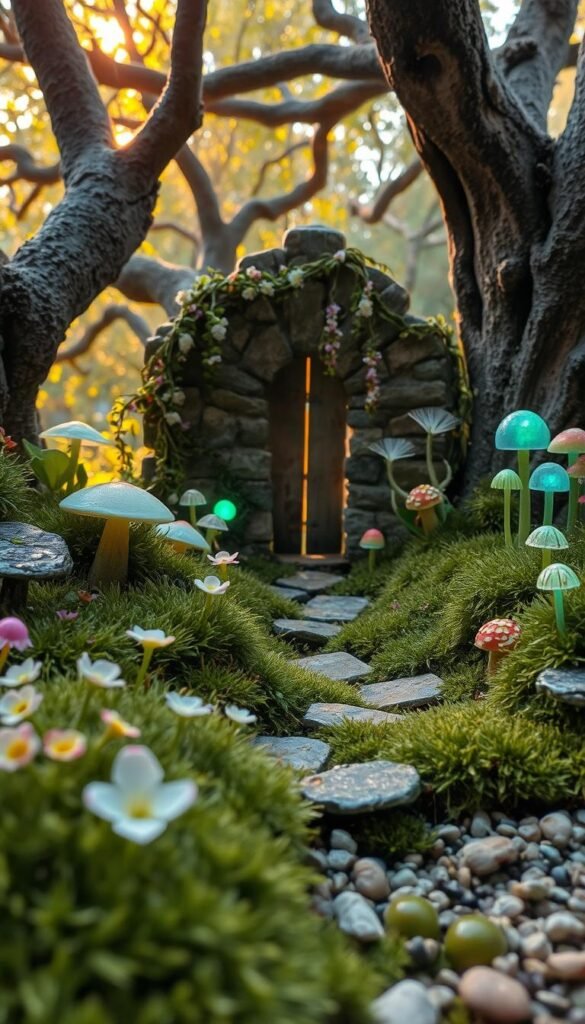
What turns ordinary soil into a portal of wonder? It’s the blend of storytelling and nature that breathes life into these tiny realms. By merging whimsical details with organic textures, you craft spaces where imagination takes root.
What Makes a Garden Fairy-Like?
Scale matters most. Miniature bridges, tiny cottages, and pebble pathways suggest a hidden world. Plants like thyme or moss mimic forests in pint-sized form. These elements spark curiosity—like discovering secrets only you can see.
Natural materials enhance authenticity. Twigs become fences, while acorn caps serve as bowls. Avoid plastic; weathered wood or stone adds age-old charm. This approach makes visitors believe magical creatures might dwell there after dark.
The Allure of Miniature Magic
Small scenes create big escapes. A desktop setup with succulents and a clay bench offers a mental retreat. In larger yards, winding trails between shrubs invite playful exploration. Both scales share one trait: they transport you somewhere lighter.
These gardens also nurture connection. Building them with family sparks creativity and patience. As you arrange stones or plant violets, stress fades. You’re not just designing a space—you’re cultivating joy, one tiny detail at a time.
Mastering Color Palettes for a Whimsical Look

Crafting a color scheme that whispers magic requires both art and science. The right hues can turn your miniature scenes into vibrant stories or peaceful hideaways. Start by considering the mood you want—serene retreats thrive on muted tones, while lively spaces pop with energy.
Balancing Bright Accents with Soft Pastels
Think of bold shades as exclamation points in your design. A single coral flowerpot or turquoise pebble path adds excitement. Pair these with soft sage greens or dusty pinks to keep the look grounded. This balance prevents visual chaos while letting key elements shine.
Utilizing the Color Wheel for Complementarity
Opposite hues on the wheel create harmony. Try pairing lavender with pale yellows for a sunrise vibe or deep teal with terracotta for earthy warmth. Test combinations in small areas first—paint a tiny planter or arrange colored stones to see how light affects them.
Struggling to plan? Explore gardening aesthetic tips for more ideas. Remember, your palette should feel cohesive but never rigid. Let nature’s randomness inspire playful tweaks that keep the charm alive.
Fairy Garden Aesthetic Tips: Color Palettes, Textures, and Layouts
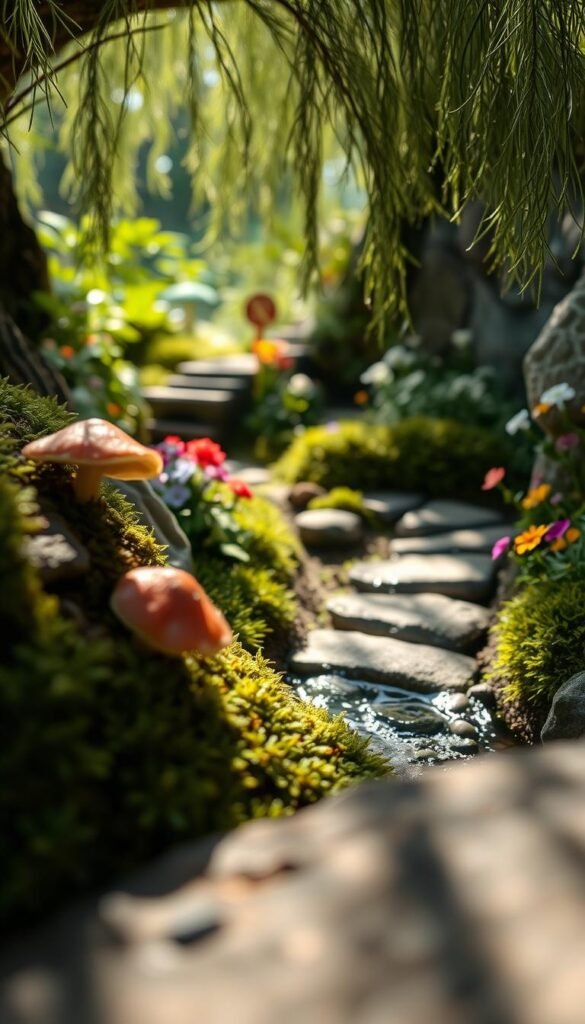
Your miniature landscape becomes a story told through hues and surfaces. Thoughtful combinations turn ordinary materials into scenes that feel alive, inviting viewers to linger over every tiny wonder.
Crafting Your Signature Color Scheme
Start by choosing a theme that sparks your imagination. Earthy greens and weathered browns craft a woodland hideaway, while metallic golds suggest hidden treasures. For seasonal flexibility, pair evergreen moss with flowers that shift hues—pale spring blues transitioning to fiery autumn oranges.
Let nature guide your palette. Lichen-covered stones offer soft gray undertones, while dried lavender adds purple whispers. These organic accents create harmony, making hand-painted decorations feel part of the environment rather than additions.
Integrating Textures for Depth
Contrast smooth river rocks with jagged bark pieces to mimic mountain terrain. Velvety moss carpets work alongside feathery ferns, creating layers that draw the eye downward. Pro tip: Place rougher materials near pathways to suggest age, while delicate petals mark special focal points.
Even small spaces benefit from tactile variety. A polished ceramic bench beside a pebble-strewn stream creates balance. These combinations trick the eye into perceiving depth, transforming flat surfaces into multidimensional worlds worth exploring.
Embracing Textures to Enhance Fairy Garden Charm
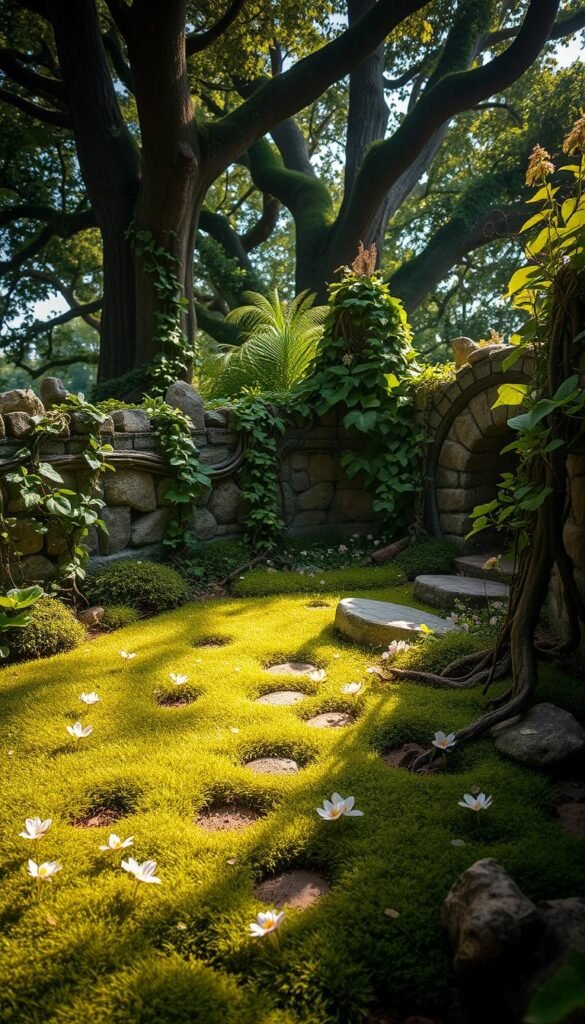
Transform ordinary materials into enchanted landscapes through tactile magic. Rough bark becomes ancient tree trunks, while moss carpets mimic rolling hills. These combinations make your creation feel inhabited by unseen caretakers.
Mixing Natural Materials with Miniature Details
Scale contrast sells the illusion. Pair chunky river rocks with delicate porcelain teacups to suggest giant boulders. Twisted vines made from jute rope climb tiny trellises, creating vertical interest. Remember: Weathered items add instant history—try rusted metal charms or cracked clay pots.
Exploring Foliage & Stone Elements
Stones do double duty as functional art. Flat slate pieces form stepping stones, while stacked pebbles become miniature cliffs. For pathways, consider mixing vintage and modern elements like brick fragments with glass beads.
| Material | Use Case | Visual Effect |
|---|---|---|
| Moss | Ground cover | Soft, lush appearance |
| Birch bark | Tree trunks | Realistic texture |
| Aquarium gravel | Stream beds | Sparkling water illusion |
Foliage choices impact mood. Feathery ferns suggest shady groves, while spiky succulents create desert vibes. Combine lamb’s ear leaves (soft) with pinecone scales (rough) for tactile contrast. This layering makes visitors want to reach in and explore.
“The best miniature scenes feel discovered, not built—like you’ve stumbled upon a secret world.”
Twigs become fences when planted upright in soil. Press lichen into clay to make textured roof shingles. With these techniques, your materials tell stories before a single fairy figurine appears.
Innovative Layouts for Magical Fairy Garden Spaces
Curves hold the secret to making compact arrangements feel expansive. Gentle bends in pathways or planting beds invite curiosity, urging visitors to wander deeper into your miniature realm. This approach transforms limited square footage into layered adventures.
Designing Cozy Corners and Pathways
Nooks become storytelling hotspots. Tuck miniature benches beneath overhanging ferns or position tiny lanterns where paths fork. Use irregular stones to outline seating areas, suggesting ancient gathering spots worn smooth by mythical feet.
Curved walkways made from pebbles or slate chips add organic flow. Let creeping thyme spill onto edges for a lived-in look. For inspiration, explore fairy garden inspiration that blends function with fantasy.
Maximizing Small Spaces with Intelligent Layouts
Stack elements vertically when ground space shrinks. Wooden shelves become tiered hillsides, while hanging baskets mimic floating islands. Elevate key features like miniature windmills on mounds to draw eyes upward.
Multi-level designs create depth. Place taller plants at the back and low-growing mosses near front edges. This simple trick makes postage-stamp areas feel like sprawling valleys. Remember: empty spots let the imagination breathe between discoveries.
Translating Fairy Garden Ideas into Home Decor & Branding
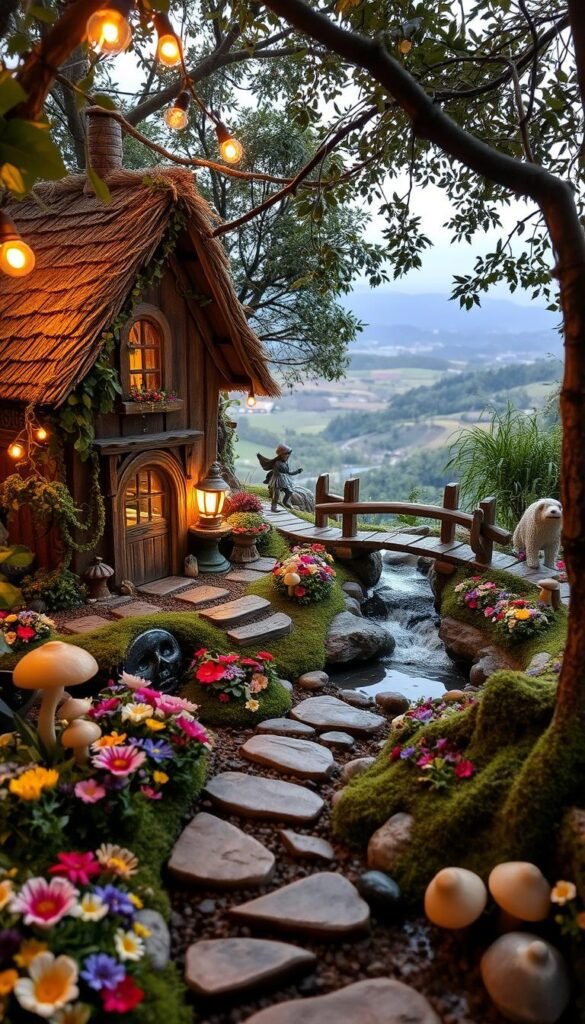
Your living space can mirror the magic of miniature landscapes with thoughtful design choices. By borrowing elements from outdoor creations, you craft rooms that feel both cozy and imaginative. Let’s explore how these concepts transform four walls into storybook settings.
Applying Nature’s Patterns Indoors
Color schemes bridge indoor and outdoor spaces seamlessly. Try the ‘Moonlit Garden’ palette in bedrooms—soft lilac walls with blush bedding promote calm. For lively gatherings, ‘Enchanted Meadow’ yellows on accent walls energize dining areas while violet throw pillows add whimsy.
Textures matter as much as hues. Jute rugs mimic mossy paths, while linen curtains echo breezy meadow grasses. Cluster ceramic vases resembling toadstools on shelves for playful focal points. These touches make your style feel connected to the earth.
| Palette Name | Room Application | Mood Created |
|---|---|---|
| Forest Canopy | Home office | Focused tranquility |
| Sunset Glade | Entryway | Warm welcome |
| Dewdrop Dawn | Bathroom | Fresh serenity |
Extend this aesthetic to branding projects. Stationery with leaf motifs or packaging using pebble-textured paper reinforces nature-inspired themes. Pro tip: Use irregular shapes in logo designs to mimic organic forms found in miniature gardens.
Creative DIY Projects for Miniature Fairy Gardens
Unlock the magic of crafting tiny worlds with everyday treasures. Building your own miniature features adds personality while stretching creativity. Let’s dive into hands-on projects that turn simple supplies into storybook settings.
Building Charming Fairy Houses
Start with sturdy bases like birch bark or cedar shingles. These materials weather beautifully and blend into natural surroundings. For rooftops, try layering pinecone scales or pressed leaves. Add character with pebble-lined windows or a mossy doorstep.
Repurposing Everyday Items into Miniatures
Old teacups become bubbling fountains when filled with blue glass beads. Broken pottery shards? Stack them into rustic staircases. Even plastic bottle caps transform into tiny tables with twig legs. The key is seeing potential in overlooked objects.
Natural elements like acorn shells and seed pods work best when sealed with matte varnish. This protects delicate items while keeping their organic look. For more ideas on combining different heights and textures in container, explore our patio gardening guide.
Remember: durability matters. Metal charms resist rain, while untreated wood may warp. Mix materials wisely to balance charm with practicality. Your creations will shine as focal points that spark joy season after season.

